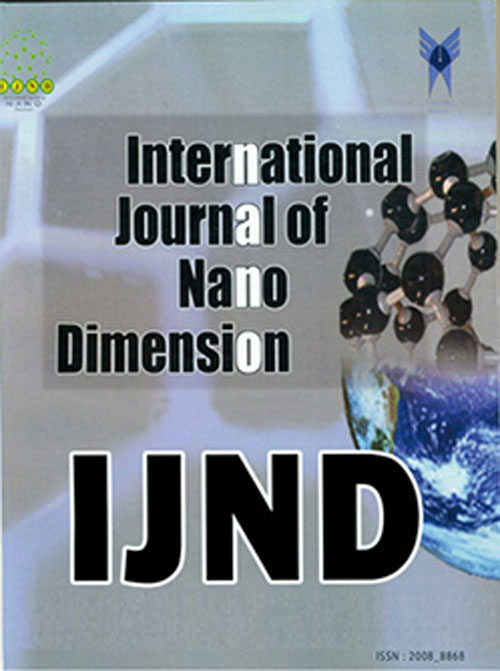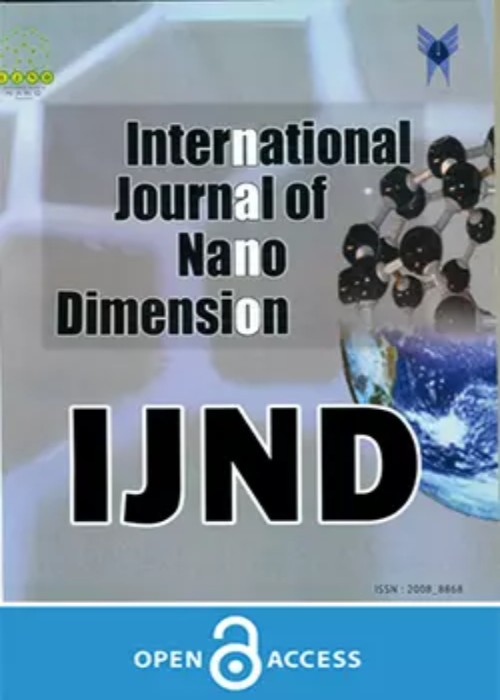فهرست مطالب

International Journal of Nano Dimension
Volume:11 Issue: 1, Winter 2020
- تاریخ انتشار: 1398/10/22
- تعداد عناوین: 10
-
-
Pages 1-11
This study was designed to experimentally measure the thermal and electrical conductivities of Aluminium Nitride/Ethylene Glycol (AlN/EG) nanofluids. Transmission electron microscopy (TEM) was used to characterize the shape of AlN nanoparticles. Nanofluids with different particle volume concentrations of 0.5%, 1%, 2%, 3%, 4%, and 5% were utilized. The thermal and electrical conductivities of the nanofluids were measured using a KD2-Pro thermal analyser and electrical conductivity meter, respectively. The obtained results revealed that the thermal conductivity of the nanofluids increased at the higher volume concentration of the nanoparticles. Thus, at 5% volume concentration, the maximum thermal conductivity enhancement of 25% was obtained. The addition of AlN nanoparticles to the EG base fluid resulted in a significant increase in the electrical conductivity of the nanofluid. An enhancement in the electrical conductivity of approximately 520 times relative to the base fluid was attained by loading a 0.5% volume concentration of AlN in EG at 28°C.
Keywords: AlN Nanoparticles, Electrical Conductivity, Nanofluid, Stability, Thermal conductivity -
Pages 12-17In this paper, we propose a new heterostructure dual material gate junctionless field-effect transistor (H-DMG-JLFET), with negative differential resistance (NDR) characteristic. The drain and channel material are silicon and source material is germanium. The gate electrode near the source is larger. A dual gate material technique is used to achieve upward band bending in order to access n-i-p-n structure which is caused by workfunction difference between electrodes and silicon. In JL-FETs as gate voltage increases, the electric-field intensifies and the band diagram profile starts to change. It is illustrated that, by increasing the gate voltage, the potential barrier decrease and the drain current increase. In the gate voltage of 0.64 V, due to appearance of a negative peak of electric-field and carriers transport within the field, the drain current decrease. Consequently, the NDR characteristic is achieved. With increase of the gate voltage the negative peak of electric-field is intensified and the drain current is decreased.Keywords: Dual Material Gate, Heterostructure, Junctionless Field Effect Transistor (H-DMG-JLFET), Negative Differential Resistance (NDR), Workfunction
-
Pages 18-25With attention to the thin film structure of colloidal quantum dot solar cells, in this paper in order to improvement of active layer absorption of them, we have proposed the use of nanostructure pattern for enhancement of their performance. For this purpose we have presented suitable nano hemisphare patterns in colloidal quantum dot solar cells for light trapping in absorption layer. Then with simulation of the obtained nanostructure solar cells we have studied on improving the absorption spectrum and thus increasing the short circuit current density of them. In order to simulation of light propagation in nanostructures, we have used finite-difference time-domain method. According to the calculation results and with optimization of periodic nanostructure patterns, we have shown that short circuit current density has been increased up to 15.95%. Absorption spectrum, quantum efficiency density and short circuit current density have been discussed for colloidal quantum dot solar cells nanostructures with low and high thickness of absorption layer in this paper.Keywords: Colloidal Quantum Dot, Finite Difference Time Domain, Nanostructure Pattern, Quantum Efficiency, Thin Film
-
Pages 26-31Spinel magnesium Cobaltite (MgCo2O4) nanoparticles with a crystalline size in the range of ∼16 nm were prepared by a simple co-precipitation technique with NaOH as a precipitant. The formation of spinel MgCo2O4 phase was confirmed by X-ray diffraction (XRD) pattern. Scanning electron microscope (SEM) images showed that aggregated nanoplates. The electrochemical performance of modified MgCo2O4 electrodes was investigated with 2M of tetrabutylammonium perchlorate (TBA) electrolyte. The cyclic voltammetry (CV) results revealed that the MgCo2O4 electrode reached the highest specific capacitance of 390 °F/g at a scan rate of 5mV/s. The excellent electrochemical performance was absorbed due to the electrochemical faradaic redox reactions related to the intercalation/de-intercalation of the tetrabutylammonium cation (TBA+) and MgCo2O4 lattice, and brings an additional pseudocapacitive contribution. The present work proves that the prepared magnesium cobaltite can serve as advanced electrode material for next generation organic electrolyte supercapacitors.Keywords: Electrode, Electrolyte, Magnesium Cobaltite, Specific Capacitance, Supercapacitor
-
Pages 32-40Un-doped and Cd-doped ZnZrO3/ZnO/ZrO2 nano composites (CDZZ-NCPs) (CD0-4) were synthesized by the hydrothermal method. The nano composites were characterized by various techniques such as Fourier Transform Infra-Red spectroscopy (FT-IR), X-ray Diffraction (XRD), Field Emission Scanning Electron Microscopy (FE-SEM) and Energy Dispersive X-Ray Analysis (EDS). The photocatalytic properties of CDZZ-NCPs (CD0-4) were studied by degradation of congo red (CR) dye under sunlight irradiation. The results reveal unique sunlight photocatalytic ability for the degradation of CR. The experimental demonstrated that the 0.03 g of ZnZrO3/ZnO/ZrO2 nano composites can degradate 50 mL of CR solution (10 ppm) during 5 minutes (up to 91.3%).Keywords: Congo Red, Nanocomposite Catalyst, Photocatalysis, Photocatalytic Degradation, Zirconium dioxide, Zinc Oxide, Zinc Zirconate
-
Pages 41-49
In this paper, a series of BaLa xGdxFe12-2xO19 (x=0.2, 0.4, 0.6 and 0.8)/PANI (polyaniline) nanocomposites synthesized for investigating the photocatalytic properties. Barium hexaferrite doped with La3+ and Gd3+ prepared via a sol-gel auto-combustion method and then the binary nanocomposites fabricated by the in situ polymerization method. (Fourier transform infrared) FTIR, (x-ray diffraction) XRD, (field emission electron microscopy) FESEM and (vibrating sample magnetometer) VSM confirmed the formation of binary nanocomposites. In FTIR analysis, the peaks at 431 and 580 cm-1 wavenumbers supported the formation of barium doped hexaferrite. At 1463 and 1554cm-1 wavenumbers, the formations of quinoid and benzenoid rings were observable. The XRD patterns of nanocomposites proved the formation of PANI by appearing the amorphous peak at 2θ=23.05 and 26.05 degrees beside the hexaferrite phase. In FESEM pictures, the sphere shape of PANI masked the whole nanoparticles of hexaferrite. In VSM hysteresis loops, by doping La3+, the saturation magnetization increased to 74 emu. Then, by adding non-magnetic part (PANI) to the magnetic hexaferrite, the saturation magnetization decreased to 11 emu. The photocatalytic properties of samples performed under the irradiation of UV-Vis light. All samples presented the photocatalytic properties. Hexaferrites as a semiconductor generated the electron-hole pairs under irradiation. PANI prevented the accumulation of electron-hole pairs on the valance band and consequently accelerated the photo-degradation of methylene blue. Kinetic studies and calculation of the correlation coefficient (R2) value which was about 0.98, proved that the photocatalytic reactions followed the Pseudo-first order kinetic.
Keywords: Hexaferrite, Methylene Blue, PANI, Photocatalytic Property, Saturation Magnetization -
Pages 50-57Due to the non-polar nature of carbon nanotubes, their use in aqueous environments is limited. Therefore, auxiliary solvents such as dimethyl sulfoxide are used to study the interactions between the amyloid-β peptide and carbon nanotubes. In this work, the interaction of Aβ (1-42), the most effective peptide in the development of Alzheimer's disease, with the carbon nanotube was performed using molecular dynamics simulation method. The simulations were carried out in the presence of various concentrations of dimethyl sulfoxide. The stability change of the salt bridge Lys28-Ala42, used in experimental studies, was investigated as a measure of aggregation tendency. Therefore, the radial distribution function of water oxygen atoms and the atoms involved in the salt bridge were used. The results show that the peak height of the radial distribution function around the oxygen of the residue Ala42 is greater than that of the Nx atom of the residue Lys28. By determining the side-chain orientation of the aromatic residues Phe4, Tyr10, Phe19, Phe20 with the carbon nanotube, it was found that the residues Phe4 and Tyr10 have a stronger interaction with the carbon nanotube than the residues Phe19 and Phe20. The results in this study are in good agreement with the experimental data and could be helpful to understand the mechanism of amyloid-β aggregation.Keywords: Alzheimer, Hydrophobicity, Peptide, Radial Distribution Function, Salt-Bridge
-
Pages 58-73In the present investigation, ZnFe2O4@MnO and MnFe2O4@ZnO magnetic nanocomposites were fabricated via a facile hydrothermal method and were calcined at 300 °C for 3 h. Synthesis of ZnFe2O4@MnO and MnFe2O4@ZnO magnetic nanocomposites optimized by the different weight percentages. The synthesized photocatalyst was characterized by X-ray diffraction (XRD), Fourier transform infrared (FT-IR), Vibrating Sample Magnetometer (VSM), EDAX (Energy dispersive X-ray Analysis), diffuse reflectance UV-vis spectroscopy (DRS) and field emission scanning electron microscopy (FESEM). The ZnFe2O4@MnO nanoparticles were found to have 20-50 nm. Magnetic studies revealed that the ZnFe2O4@MnO and MnFe2O4@ZnO nanocomposites can be easily separated from the solution by an external magnetic field. The photocatalytic degradation of Congo red dye (CR) was investigated based on the removal of Congo red (CR) in aqueous solution in 35 min of visible light irradiation. Compared with MnFe2O4@ZnO nanocomposite, the ZnFe2O4@MnO nanocomposite showed high photocatalytic performance on the photodegradation of Congo red. Effect of reaction time, pH, and loading of ZnO on degradation of CR was studied,The results demonstrated that the degradation efficiency of ZnFe2O4@MnO nanocomposite (98.5%) was better than that of MnFe2O4@ZnO nanocomposite (90.32%), which is due to the presence of narrow band gap energy of ZnFe2O4@MnO.Kinetics studies have displayed that the degradation of CR by the prepared of photocatalysts follows the pseudo-first-order kinetics and the rate constant achieved for ZnFe2O4@MnO (k=0.0371 min−1) was much greater than of MnFe2O4@ZnO (k=0.0321 min−1). The synthesized ZnFe2O4@MnO nanocomposite can be potentially applied as a magnetically separable photocatalyst to deal with water pollution problems.Keywords: Congo Red, Hydrothermal Method, Magnetical Nanocomposites, Photocatalytic Activity, Visible Light
-
Pages 74-87Liquid desiccants such as glycols are used in dehydration process, among which Triethylene Glycol (TEG) is considered as a common choice. The addition of nanoparticles to TEG as the base fluid is one of the prevalent method to improve thermal properties of TEG. In this study, an experimental investigation was performed on thermal conductivity of TEG-based nanofluids with 20 and 40 nm diameter copper oxide (CuO) nanoparticles analyzed at different conditions. Thermal conductivity was measured using a Decagon thermal analyzer (KD2 Pro Model) in the 20 °C-60 °C temperature range, and also 0.1- 0.9 wt.% range. The experimental results showed that thermal conductivity of the nanofluid enhances with temperature increasing. In addition, thermal conductivity of nanofluids increased with nanoparticle concentration in both cases of 20 and 40 nm nanoparticles. The highest enhancement was also ~ 13.5%, for the nanofluid with 20 nm nanoparticles at 60 °C and a 0.9 wt.% concentration.Keywords: CuO Nanoparticle, Dehydration, Nanofluid, Thermal conductivity, Triethylene Glycol
-
Pages 88-98
The novel approach has been carried for the green synthesis of silver nanoparticles using leaf extract of Cinnamomum tamala and silver nitrate solution. The optimal condition for synthesizing Ag-NPs was obtained by varying the leaf extract concentration, temperature, AgNO3 concentration, effect of ratio of leaf extract to AgNO3 solution,pH and reaction time. The formation of silver nanoparticles was confirmed by UV–Vis spectrophotometer. Fourier transform infrared spectroscopy (FTIR) was used to key out the specific functional groups responsible for the reduction of silver nitrate to form silver nanoparticles and the capping agents present in the leaf extract. Scanning electron microscopy (SEM) represents the morphological characterization of synthesized nanomaterials. Transmission electron microscopy (TEM) analysis revealed that the particles were crystalline, spherical and irregular in shape and the size were 16 nm and 9 nm at 25 °C and 60 °C, respectively. Electron X-ray diffraction (XRD) analysis is used to determine the phase distribution, crystallinity and purity of the synthesized nanoparticles. The synthesized nanoparticles are found to be highly effective against some pathogenic bacteria species, thus signification of the present study is in production of various pharmaceutical and bioactive products.
Keywords: Antibacterial activity, Cinnamomum Tamala, Green synthesis, silver nanoparticles, Spectral Analysis


